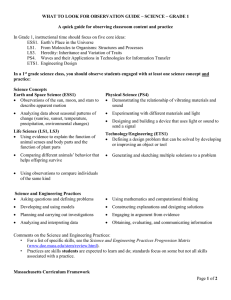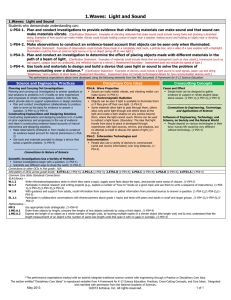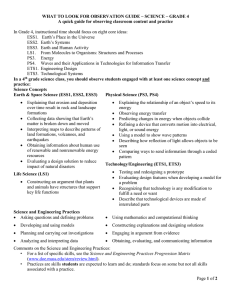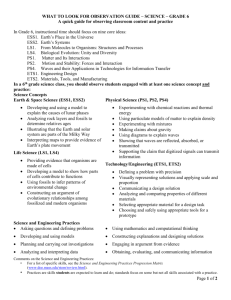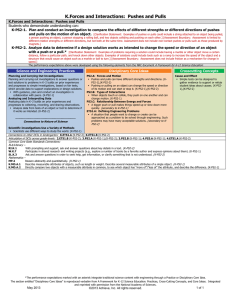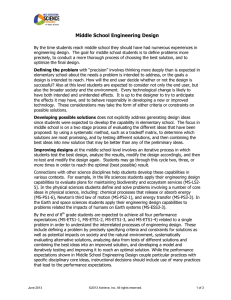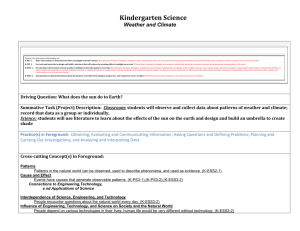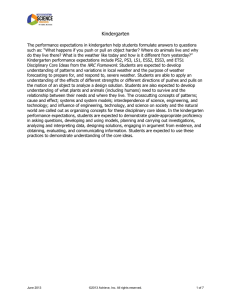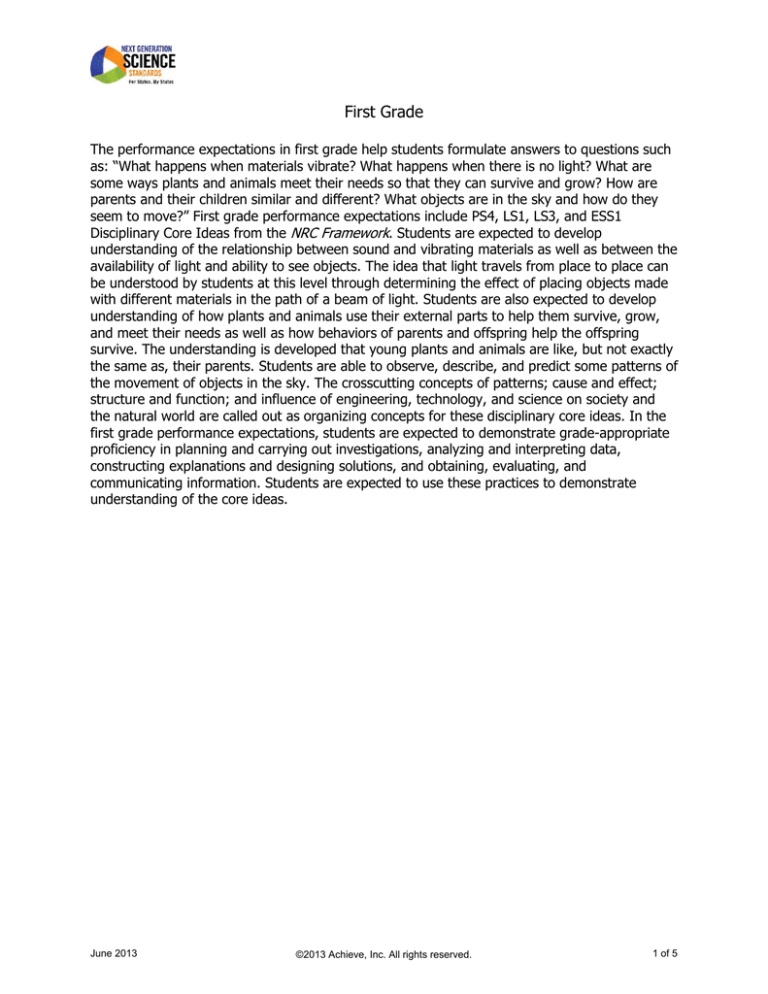
First Grade
The performance expectations in first grade help students formulate answers to questions such
as: “What happens when materials vibrate? What happens when there is no light? What are
some ways plants and animals meet their needs so that they can survive and grow? How are
parents and their children similar and different? What objects are in the sky and how do they
seem to move?” First grade performance expectations include PS4, LS1, LS3, and ESS1
Disciplinary Core Ideas from the NRC Framework. Students are expected to develop
understanding of the relationship between sound and vibrating materials as well as between the
availability of light and ability to see objects. The idea that light travels from place to place can
be understood by students at this level through determining the effect of placing objects made
with different materials in the path of a beam of light. Students are also expected to develop
understanding of how plants and animals use their external parts to help them survive, grow,
and meet their needs as well as how behaviors of parents and offspring help the offspring
survive. The understanding is developed that young plants and animals are like, but not exactly
the same as, their parents. Students are able to observe, describe, and predict some patterns of
the movement of objects in the sky. The crosscutting concepts of patterns; cause and effect;
structure and function; and influence of engineering, technology, and science on society and
the natural world are called out as organizing concepts for these disciplinary core ideas. In the
first grade performance expectations, students are expected to demonstrate grade-appropriate
proficiency in planning and carrying out investigations, analyzing and interpreting data,
constructing explanations and designing solutions, and obtaining, evaluating, and
communicating information. Students are expected to use these practices to demonstrate
understanding of the core ideas.
June 2013
©2013 Achieve, Inc. All rights reserved.
1 of 5
1.Waves: Light and Sound
1.Waves: Light and Sound
Students who demonstrate understanding can:
1-PS4-1. Plan and conduct investigations to provide evidence that vibrating materials can make sound and that sound can
make materials vibrate. [Clarification Statement: Examples of vibrating materials that make sound could include tuning forks and plucking a stretched
string. Examples of how sound can make matter vibrate could include holding a piece of paper near a speaker making sound and holding an object near a vibrating
tuning fork.]
1-PS4-2. Make observations to construct an evidence-based account that objects can be seen only when illuminated.
[Clarification Statement: Examples of observations could include those made in a completely dark room, a pinhole box, and a video of a cave explorer with a flashlight.
Illumination could be from an external light source or by an object giving off its own light.]
1-PS4-3. Plan and conduct an investigation to determine the effect of placing objects made with different materials in the
path of a beam of light. [Clarification Statement: Examples of materials could include those that are transparent (such as clear plastic), translucent (such as
wax paper), opaque (such as cardboard), and reflective (such as a mirror).] [Assessment Boundary: Assessment does not include the speed of light.]
1-PS4-4. Use tools and materials to design and build a device that uses light or sound to solve the problem of
communicating over a distance.* [Clarification Statement: Examples of devices could include a light source to send signals, paper cup and string
“telephones,” and a pattern of drum beats.] [Assessment Boundary: Assessment does not include technological details for how communication devices work.]
The performance expectations above were developed using the following elements from the NRC document A Framework for K-12 Science Education:
Science and Engineering Practices
Disciplinary Core Ideas
Planning and Carrying Out Investigations
Planning and carrying out investigations to answer questions or
test solutions to problems in K–2 builds on prior experiences
and progresses to simple investigations, based on fair tests,
which provide data to support explanations or design solutions.
Plan and conduct investigations collaboratively to produce
data to serve as the basis for evidence to answer a
question. (1-PS4-1),(1-PS4-3)
Constructing Explanations and Designing Solutions
Constructing explanations and designing solutions in K–2 builds
on prior experiences and progresses to the use of evidence
and ideas in constructing evidence-based accounts of natural
phenomena and designing solutions.
Make observations (firsthand or from media) to construct
an evidence-based account for natural phenomena (1-PS42)
Use tools and materials provided to design a device that
solves a specific problem. (1-PS4-4)
PS4.A: Wave Properties
Sound can make matter vibrate, and vibrating matter can
make sound. (1-PS4-1)
PS4.B: Electromagnetic Radiation
Objects can be seen if light is available to illuminate them
or if they give off their own light. (1-PS4-2)
Some materials allow light to pass through them, others
allow only some light through and others block all the
light and create a dark shadow on any surface beyond
them, where the light cannot reach. Mirrors can be used
to redirect a light beam. (Boundary: The idea that light
travels from place to place is developed through
experiences with light sources, mirrors, and shadows, but
no attempt is made to discuss the speed of light.) (1PS4-3)
PS4.C: Information Technologies and
Instrumentation
People also use a variety of devices to communicate
(send and receive information) over long distances. (1PS4-4)
--------------------------------------------------------
Connections to Nature of Science
Crosscutting Concepts
Cause and Effect
Simple tests can be designed to gather
evidence to support or refute student ideas
about causes. (1-PS4-1),(1-PS4-2),(1-PS4-3)
-------------------------------------------------
Connections to Engineering, Technology,
and Applications of Science
Influence of Engineering, Technology, and
Science, on Society and the Natural World
People depend on various technologies in their
lives; human life would be very different
without technology. (1-PS4-4)
Scientific Investigations Use a Variety of Methods
Science investigations begin with a question. (1-PS4-1)
Scientists use different ways to study the world. (1-PS4-1)
Connections to other DCIs in first grade: N/A
Articulation of DCIs across grade-levels: K.ETS1.A (1-PS4-4); 2.PS1.A (1-PS4-3); 2.ETS1.B (1-PS4-4); 4.PS4.C (1-PS4-4); 4.PS4.B (1-PS4-2); 4.ETS1.A (1-PS4-4)
Common Core State Standards Connections:
ELA/Literacy –
Write informative/explanatory texts in which they name a topic, supply some facts about the topic, and provide some sense of closure. (1-PS4-2)
Participate in shared research and writing projects (e.g., explore a number of “how-to” books on a given topic and use them to write a sequence of instructions). (1-PS41),(1-PS4-2),(1-PS4-3),(1-PS4-4)
With guidance and support from adults, recall information from experiences or gather information from provided sources to answer a question. (1-PS4-1),(1-PS4-2),(1PS4-3)
Participate in collaborative conversations with diverse partners about grade 1 topics and texts with peers and adults in small and larger groups. (1-PS4-1),(1-PS4-2),(1-
W.1.2
W.1.7
W.1.8
SL.1.1
Mathematics –
MP.5
1.MD.A.1
1.MD.A.2
PS4-3)
Use appropriate tools strategically. (1-PS4-4)
Order three objects by length; compare the lengths of two objects indirectly by using a third object. (1-PS4-4)
Express the length of an object as a whole number of length units, by layering multiple copies of a shorter object (the length unit) end to end; understand that the
length measurement of an object is the number of same-size length units that span it with no gaps or overlaps. (1-PS4-4)
*The performance expectations marked with an asterisk integrate traditional science content with engineering through a Practice or Disciplinary Core Idea.
The section entitled “Disciplinary Core Ideas” is reproduced verbatim from A Framework for K-12 Science Education: Practices, Cross-Cutting Concepts, and Core Ideas. Integrated
and reprinted with permission from the National Academy of Sciences.
June 2013
©2013 Achieve, Inc. All rights reserved.
2 of 5
1.Structure, Function, and Information Processing
1.Structure, Function, and Information Processing
Students who demonstrate understanding can:
1-LS1-1. Use materials to design a solution to a human problem by mimicking how plants and/or animals use their external
parts to help them survive, grow, and meet their needs.* [Clarification Statement: Examples of human problems that can be solved by
mimicking plant or animal solutions could include designing clothing or equipment to protect bicyclists by mimicking turtle shells, acorn shells, and animal scales;
stabilizing structures by mimicking animal tails and roots on plants; keeping out intruders by mimicking thorns on branches and animal quills; and, detecting intruders
by mimicking eyes and ears.]
1-LS1-2. Read texts and use media to determine patterns in behavior of parents and offspring that help offspring survive.
[Clarification Statement: Examples of patterns of behaviors could include the signals that offspring make (such as crying, cheeping, and other vocalizations) and the
responses of the parents (such as feeding, comforting, and protecting the offspring).]
1-LS3-1. Make observations to construct an evidence-based account that young plants and animals are like, but not exactly
like, their parents. [Clarification Statement: Examples of patterns could include features plants or animals share. Examples of observations could include
leaves from the same kind of plant are the same shape but can differ in size; and, a particular breed of dog looks like its parents but is not exactly the same.]
[Assessment Boundary: Assessment does not include inheritance or animals that undergo metamorphosis or hybrids.]
The performance expectations above were developed using the following elements from the NRC document A Framework for K-12 Science Education:
Science and Engineering Practices
Disciplinary Core Ideas
Constructing Explanations and Designing Solutions
Constructing explanations and designing solutions in K–2
builds on prior experiences and progresses to the use of
evidence and ideas in constructing evidence-based accounts
of natural phenomena and designing solutions.
Make observations (firsthand or from media) to
construct an evidence-based account for natural
phenomena. (1-LS3-1)
Use materials to design a device that solves a specific
problem or a solution to a specific problem. (1-LS1-1)
Obtaining, Evaluating, and Communicating
Information
Obtaining, evaluating, and communicating information in K–
2 builds on prior experiences and uses observations and
texts to communicate new information.
Read grade-appropriate texts and use media to obtain
scientific information to determine patterns in the
natural world. (1-LS1-2)
LS1.A: Structure and Function
All organisms have external parts. Different animals use their body
parts in different ways to see, hear, grasp objects, protect
themselves, move from place to place, and seek, find, and take in
food, water and air. Plants also have different parts (roots, stems,
leaves, flowers, fruits) that help them survive and grow. (1-LS1-1)
LS1.B: Growth and Development of Organisms
Adult plants and animals can have young. In many kinds of
animals, parents and the offspring themselves engage in
behaviors that help the offspring to survive. (1-LS1-2)
LS1.D: Information Processing
Animals have body parts that capture and convey different kinds
of information needed for growth and survival. Animals respond to
these inputs with behaviors that help them survive. Plants also
respond to some external inputs. (1-LS1-1)
LS3.A: Inheritance of Traits
Young animals are very much, but not exactly, like their parents.
Plants also are very much, but not exactly, like their parents. (1LS3-1)
LS3.B: Variation of Traits
Individuals of the same kind of plant or animal are recognizable as
similar but can also vary in many ways. (1-LS3-1)
-----------------------------------------------
Connections to Nature of Science
Crosscutting Concepts
Patterns
Patterns in the natural world can be
observed, used to describe phenomena,
and used as evidence. (1-LS1-2),(1-LS31)
Structure and Function
The shape and stability of structures of
natural and designed objects are related
to their function(s). (1-LS1-1)
----------------------------------------------
Connections to Engineering, Technology,
and Applications of Science
Influence of Engineering, Technology,
and Science on Society and the Natural
World
Every human-made product is designed
by applying some knowledge of the
natural world and is built by built using
materials derived from the natural world.
(1-LS1-1)
Scientific Knowledge is Based on Empirical Evidence
Scientists look for patterns and order when making
observations about the world. (1-LS1-2)
Connections to other DCIs in first grade: N/A
Articulation of DCIs across grade-levels: K.ETS1.A (1-LS1-1); 3.LS2.D (1-LS1-2) 3.LS3.A (1-LS3-1); 3.LS3.B (1-LS3-1); 4.LS1.A (1-LS1-1); 4.LS1.D (1-LS1-1); 4.ETS1.A (1-LS1-1)
Common Core State Standards Connections:
ELA/Literacy –
RI.1.1
RI.1.2
RI.1.10
W.1.7
W.1.8
Mathematics –
MP.2
MP.5
1.NBT.B.3
1.NBT.C.4
Ask and answer questions about key details in a text. (1-LS1-2),(1-LS3-1)
Identify the main topic and retell key details of a text. (1-LS1-2)
With prompting and support, read informational texts appropriately complex for grade. (1-LS1-2)
Participate in shared research and writing projects (e.g., explore a number of “how-to” books on a given topic and use them to write a sequence of instructions). (1-LS11),(1-LS3-1)
With guidance and support from adults, recall information from experiences or gather information from provided sources to answer a question. (1-LS3-1)
Reason abstractly and quantitatively. (1-LS3-1)
Use appropriate tools strategically. (1-LS3-1)
Compare two two-digit numbers based on the meanings of the tens and one digits, recording the results of comparisons with the symbols , , and . (1-LS1-2)
Add within 100, including adding a two-digit number and a one-digit number, and adding a two-digit number and a multiple of 10, using concrete models or drawings
and strategies based on place value, properties of operations, and/or the relationship between addition and subtraction; relate the strategy to a written method and
explain the reasoning uses. Understand that in adding two-digit numbers, one adds tens and tens, ones and ones; and sometimes it is necessary to compose a ten. (1-
LS1-2)
1.NBT.C.5
1.NBT.C.6
1.MD.A.1
Given a two-digit number, mentally find 10 more or 10 less than the number, without having to count; explain the reasoning used. (1-LS1-2)
Subtract multiples of 10 in the range 10-90 from multiples of 10 in the range 10-90 (positive or zero differences), using concrete models or drawings and strategies
based on place value, properties of operations, and/or the relationship between addition and subtraction; relate the strategy to a written method and explain the
reasoning used. (1-LS1-2)
Order three objects by length; compare the lengths of two objects indirectly by using a third object. (1-LS3-1)
*The performance expectations marked with an asterisk integrate traditional science content with engineering through a Practice or Disciplinary Core Idea.
The section entitled “Disciplinary Core Ideas” is reproduced verbatim from A Framework for K-12 Science Education: Practices, Cross-Cutting Concepts, and Core Ideas. Integrated
and reprinted with permission from the National Academy of Sciences.
June 2013
©2013 Achieve, Inc. All rights reserved.
3 of 5
1.Space Systems: Patterns and Cycles
1.Space Systems: Patterns and Cycles
Students who demonstrate understanding can:
1-ESS1-1. Use observations of the sun, moon, and stars to describe patterns that can be predicted.
[Clarification Statement: Examples
of patterns could include that the sun and moon appear to rise in one part of the sky, move across the sky, and set; and stars other than our sun are visible at night
but not during the day.] [Assessment Boundary: Assessment of star patterns is limited to stars being seen at night and not during the day.]
1-ESS1-2. Make observations at different times of year to relate the amount of daylight to the time of year.
[Clarification
Statement: Emphasis is on relative comparisons of the amount of daylight in the winter to the amount in the spring or fall.] [Assessment Boundary: Assessment is
limited to relative amounts of daylight, not quantifying the hours or time of daylight.]
The performance expectations above were developed using the following elements from the NRC document A Framework for K-12 Science Education:
Science and Engineering Practices
Disciplinary Core Ideas
Planning and Carrying Out Investigations
ESS1.A: The Universe and its Stars
Planning and carrying out investigations to answer questions or
Patterns of the motion of the sun, moon, and stars in
test solutions to problems in K–2 builds on prior experiences and
the sky can be observed, described, and predicted. (1progresses to simple investigations, based on fair tests, which
ESS1-1)
provide data to support explanations or design solutions.
ESS1.B: Earth and the Solar System
Make observations (firsthand or from media) to collect data
Seasonal patterns of sunrise and sunset can be
that can be used to make comparisons. (1-ESS1-2)
observed, described, and predicted. (1-ESS1-2)
Analyzing and Interpreting Data
Analyzing data in K–2 builds on prior experiences and progresses to
collecting, recording, and sharing observations.
Use observations (firsthand or from media) to describe patterns
in the natural world in order to answer scientific questions. (1ESS1-1)
Connections to other DCIs in first grade: N/A
Articulation of DCIs across grade-levels: 3.PS2.A (1-ESS1-1); 5.PS2.B (1-ESS1-1),(1-ESS1-2) 5-ESS1.B (1-ESS1-1),(1-ESS1-2)
Crosscutting Concepts
Patterns
Patterns in the natural world can be
observed, used to describe phenomena, and
used as evidence. (1-ESS1-1),(1-ESS1-2)
-----------------------------------------------
Connections to Nature of Science
Scientific Knowledge Assumes an Order and
Consistency in Natural Systems
Science assumes natural events happen today
as they happened in the past. (1-ESS1-1)
Many events are repeated. (1-ESS1-1)
Common Core State Standards Connections:
ELA/Literacy –
W.1.7
W.1.8
Mathematics –
MP.2
MP.4
MP.5
1.OA.A.1
1.MD.C.4
Participate in shared research and writing projects (e.g., explore a number of “how-to” books on a given topic and use them to write a sequence of instructions). (1ESS1-1),(1-ESS1-2)
With guidance and support from adults, recall information from experiences or gather information from provided sources to answer a question. (1-ESS1-1),(1-ESS1-2)
Reason abstractly and quantitatively. (1-ESS1-2)
Model with mathematics. (1-ESS1-2)
Use appropriate tools strategically. (1-ESS1-2)
Use addition and subtraction within 20 to solve word problems involving situations of adding to, taking from, putting together, taking apart, and comparing, with
unknowns in all positions, e.g., by using objects, drawings, and equations to represent the problem. (1-ESS1-2)
Organize, represent, and interpret data with up to three categories; ask and answer questions about the total number of data points, how many in each category, and
how many more or less are in one category than in another. (1-ESS1-2)
*The performance expectations marked with an asterisk integrate traditional science content with engineering through a Practice or Disciplinary Core Idea.
The section entitled “Disciplinary Core Ideas” is reproduced verbatim from A Framework for K-12 Science Education: Practices, Cross-Cutting Concepts, and Core Ideas. Integrated
and reprinted with permission from the National Academy of Sciences.
June 2013
©2013 Achieve, Inc. All rights reserved.
4 of 5
K-2.Engineering Design
K-2.Engineering Design
Students who demonstrate understanding can:
K-2-ETS1-1. Ask questions, make observations, and gather information about a situation people want to change to define a
simple problem that can be solved through the development of a new or improved object or tool.
K-2-ETS1-2. Develop a simple sketch, drawing, or physical model to illustrate how the shape of an object helps it function
as needed to solve a given problem.
K-2-ETS1-3. Analyze data from tests of two objects designed to solve the same problem to compare the strengths and
weaknesses of how each performs.
The performance expectations above were developed using the following elements from the NRC document A Framework for K-12 Science Education:
Science and Engineering Practices
Asking Questions and Defining Problems
Asking questions and defining problems in K–2 builds on prior
experiences and progresses to simple descriptive questions.
Ask questions based on observations to find more
information about the natural and/or designed world. (K-2ETS1-1)
Define a simple problem that can be solved through the
development of a new or improved object or tool. (K-2ETS1-1)
Developing and Using Models
Modeling in K–2 builds on prior experiences and progresses to
include using and developing models (i.e., diagram, drawing,
physical replica, diorama, dramatization, or storyboard) that
represent concrete events or design solutions.
Develop a simple model based on evidence to represent a
proposed object or tool. (K-2-ETS1-2)
Analyzing and Interpreting Data
Analyzing data in K–2 builds on prior experiences and
progresses to collecting, recording, and sharing observations.
Analyze data from tests of an object or tool to determine if
it works as intended. (K-2-ETS1-3)
Disciplinary Core Ideas
ETS1.A: Defining and Delimiting Engineering Problems
A situation that people want to change or create can be
approached as a problem to be solved through engineering. (K-2ETS1-1)
Asking questions, making observations, and gathering information
are helpful in thinking about problems. (K-2-ETS1-1)
Before beginning to design a solution, it is important to clearly
understand the problem. (K-2-ETS1-1)
ETS1.B: Developing Possible Solutions
Designs can be conveyed through sketches, drawings, or physical
models. These representations are useful in communicating ideas
for a problem’s solutions to other people. (K-2-ETS1-2)
ETS1.C: Optimizing the Design Solution
Because there is always more than one possible solution to a
problem, it is useful to compare and test designs. (K-2-ETS1-3)
Crosscutting Concepts
Structure and Function
The shape and stability of structures
of natural and designed objects are
related to their function(s). (K-2ETS1-2)
Connections to K-2-ETS1.A: Defining and Delimiting Engineering Problems include:
Kindergarten: K-PS2-2, K-ESS3-2
Connections to K-2-ETS1.B: Developing Possible Solutions to Problems include:
Kindergarten: K-ESS3-3, First Grade: 1-PS4-4, Second Grade: 2-LS2-2
Connections to K-2-ETS1.C: Optimizing the Design Solution include:
Second Grade: 2-ESS2-1
Articulation of DCIs across grade-bands: 3-5.ETS1.A (K-2-ETS1-1),(K-2-ETS1-2),(K-2 -ETS1-3); 3-5.ETS1.B (K-2-ETS1-2),(K-2-ETS1-3); 3-5.ETS1.C (K-2-ETS1-1),(K-2-ETS1-2),(K2-ETS1-3)
Common Core State Standards Connections:
ELA/Literacy –
RI.2.1
W.2.6
W.2.8
SL.2.5
Mathematics –
2.MD.D.10
Ask and answer such questions as who, what, where, when, why, and how to demonstrate understanding of key details in a text. (K-2-ETS1-1)
With guidance and support from adults, use a variety of digital tools to produce and publish writing, including in collaboration with peers. (K-2-ETS1-1),(K-2-ETS1-3)
Recall information from experiences or gather information from provided sources to answer a question. (K-2-ETS1-1),(K-2-ETS1-3)
Create audio recordings of stories or poems; add drawings or other visual displays to stories or recounts of experiences when appropriate to clarify ideas, thoughts, and
feelings. (K-2-ETS1-2)
Draw a picture graph and a bar graph (with single-unit scale) to represent a data set with up to four categories. Solve simple put-together, take-apart, and compare
problems using information presented in a bar graph. (K-2-ETS1-1),(K-2-ETS1-3)
The section entitled “Disciplinary Core Ideas” is reproduced verbatim from A Framework for K-12 Science Education: Practices, Cross-Cutting Concepts, and Core Ideas. Integrated
and reprinted with permission from the National Academy of Sciences.
June 2013
©2013 Achieve, Inc. All rights reserved.
5 of 5

